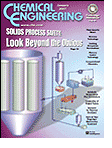Recommended :
- Subscribe FREE - Chemical Engineering
- Tips on Succession in FREE Subscription
 Earlier post "Assess Potential Piping Failure Due to CV, BDV & PRV Quick Opening with Vapor Discharge" discussed about severe vibration and peak force act on the piping due to quick opening of valve. An assessment method to assess the potential failure of piping due to quick opening of valve has been presented. The equation in determining peak for is mainly for dry gas and/or vapor. This post will focus on two phase vapor liquid at the outlet of valve.
Earlier post "Assess Potential Piping Failure Due to CV, BDV & PRV Quick Opening with Vapor Discharge" discussed about severe vibration and peak force act on the piping due to quick opening of valve. An assessment method to assess the potential failure of piping due to quick opening of valve has been presented. The equation in determining peak for is mainly for dry gas and/or vapor. This post will focus on two phase vapor liquid at the outlet of valve.
- Subscribe FREE - Chemical Engineering
- Tips on Succession in FREE Subscription
Peak force induced by sudden two-phase vapor liquid release
When a valve quick open from FULL Close to FULL Open, instantaneously release two-phase vapor liquid at downstream piping results peak force (FMax, kN) considering two-phase vapor liquid is in homogenous flow or frozen flow with no-slip.
where
W = Vapor mass flow (kg/s)
Di = Pipe internal diameter (m)
x = Vapor mass fraction
ρV = Vapor density (kg/m
ρL = Liquid density (kg/m
Piping Limiting Force
A steel piping with Piping limiting force (FLimit, kN),
with piping wall thickness correction factor,
where
Do = Pipe external diameter (m)
Di = Pipe internal diameter (m)
Wt = Pipe wall thickness (mm)
WtSch_40 = Schedule 40 pipe wall thickness (mm)
C = Pipe support correction factor
Pipe support stiffness level and correction factor
Pipe support stiffness level and correction factor subjects to support span length (LS) and pipe external diameter (Do) which can be determined from below chart.
Read more in "Quick Determination Pipe Support Stiffness Level and Correction Factor" for equations for differentiating support type.
Assessment Criteria
To ensure piping will not failed on sudden opening of valve, the following shall be met :
FMax < 0.3 FLimit
In the event FMax is more than 0.3 but less than 0.5 of FLimit, a detail small bore connection checking shall be conducted.
Ref :
1. "Guideline for avoidance of vibration induced fatigue in process work"
Ref :
1. "Guideline for avoidance of vibration induced fatigue in process work"
Related Post
- Assess Potential Piping Failure Due to CV, BDV & PRV Quick Opening with Vapor Discharge
- Quick Determination Pipe Support Stiffness Level and Correction Factor
- Check Valve Types and Selection
- Anti-surge Control (ASC) or Capacity Control (CC) Valve in Vertical Upward Run ?
- Combine Anti-surge control (ASC) & Capacity Control (CC) Functions ?
- Potential Problem associate with Double NRV in Series within a Line
- Several Strategies To Minimize Relief Capacity in Back-Flow Scenario




No comments:
Post a Comment